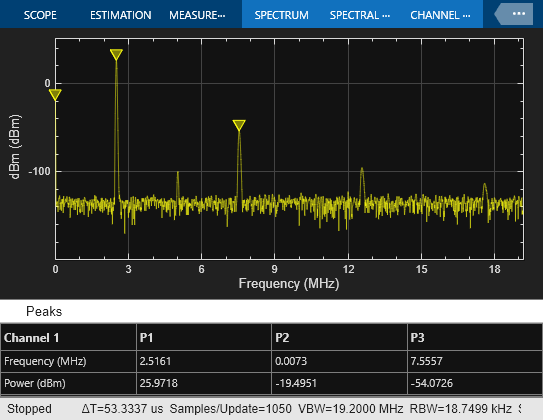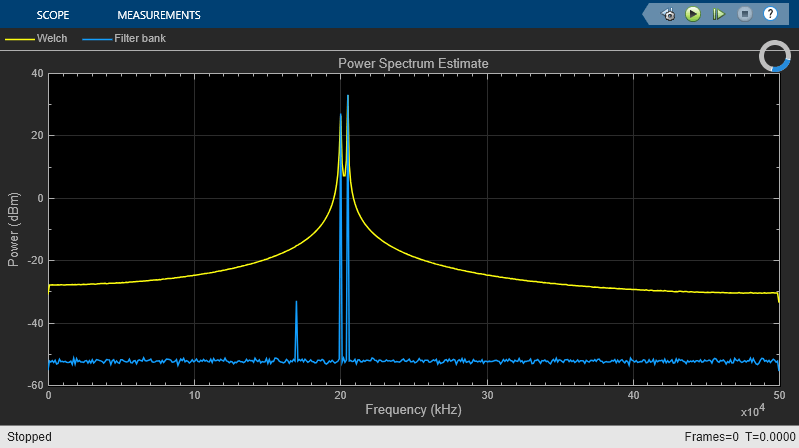频谱分析仪
显示频谱
库:
DSP System Toolbox /
Sinks
Audio Toolbox /
Sinks
DSP System Toolbox HDL Support /
Sinks
描述
Spectrum Analyzer 模块(在此处称为示波器)显示频域信号和时域信号的频谱。示波器显示频谱视图和频谱图视图。模块算法使用滤波器组方法和韦尔奇平均修正周期图方法执行频谱估计。您可以自定义频谱分析仪显示画面,以显示您需要的数据和测量信息。有关详细信息,请参阅算法。
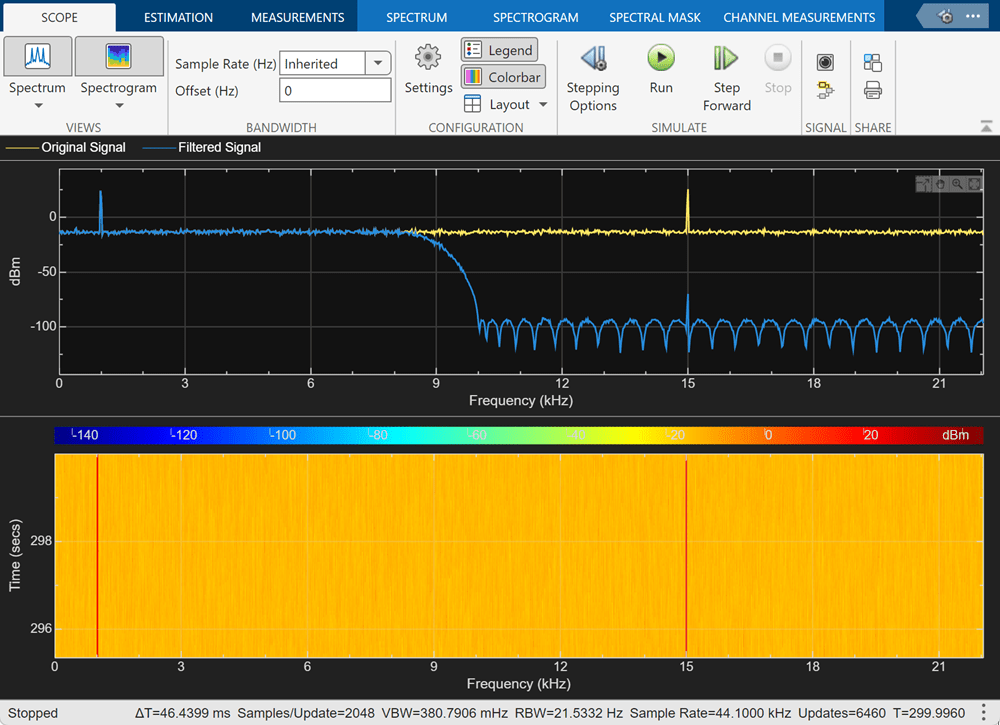
您可以在普通或加速仿真模式下运行的模型中使用 Spectrum Analyzer 模块。您还可以在快速加速或外部仿真模式下运行的模型中使用 Spectrum Analyzer 模块,但存在一些限制。
您可以在所有子系统和条件子系统内使用频谱分析仪模块。条件子系统包括使能子系统、触发子系统、使能触发子系统以及函数调用子系统。有关详细信息,请参阅条件执行子系统概述。
测量值
编程控制
使用 SpectrumAnalyzerBlockConfiguration (DSP System Toolbox) 对象从命令行配置和显示频谱分析仪设置。
示例
此示例说明如何使用 Spectrum Analyzer 模块可视化频率输入信号。

要使用 Spectrum Analyzer 模块可视化频域输入信号,请在频谱分析仪工具条的估计选项卡中,将输入域设置为 Frequency。在频谱选项卡中,清除双边频谱参数。
运行模型。您可以看到两个峰值。要测量峰值,请启用测量选项卡中的峰值查找器。
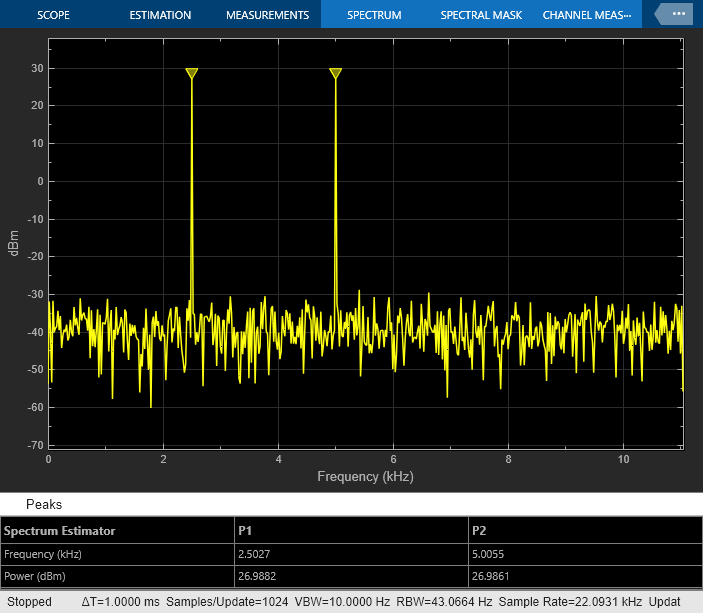
通过使用 Variable FIR Decimation (DSP System Toolbox) 模块更改抽取因子来抽取正弦信号。在运行仿真时,可以在模块对话框中或通过输入端口更改抽取因子。
打开并检查模型
打开 DisplayVariableSizeSignalonSpectrumAnalyzer 模型。
模型中的输入信号是频率为 1 kHz 和 10 kHz 的两个正弦波之和,采样时间为 1/44100 秒,每帧包含 256 个采样。Random Source 模块将方差为 0.05 的零均值高斯白噪声与正弦波之和相加。
使此信号通过 Variable FIR Decimation 模块。模块中的最大抽取因子参数设置为 24。您可以通过输入端口指定抽取因子,并使用 Manual Switch 模块对其进行更改。Variable FIR Decimation 模块的输出是可变大小信号,其帧大小根据您指定的抽取因子而变化。
运行模型
在频谱分析仪中可视化被抽取信号的频谱。频谱分析仪的采样率根据信号的帧大小和信号的采样率进行更新。
当抽取因子设为 2 时,输出帧大小是输入帧大小的一半,频谱分析仪使用 44100/2(即 22.05 kHz)的采样率。


在仿真运行时,将抽取因子更改为 4。您可以看到频谱分析仪的采样率调整为 44100/4(即 11.025 kHz)。1 kHz 的音调保持不变,而 10 kHz 的音调在频谱分析仪中不再可见,因为频谱跨度现在为 [0 Fs/2] = [0 5.5125 kHz]。


使用 Spectrum Analyzer 模块计算并显示含噪正弦输入信号的功率谱。通过启用以下模块配置属性来测量频谱中的光标位置、相邻通道功率比、失真和峰值:
CursorMeasurementsChannelMeasurementsDistortionMeasurementsPeakFinder
打开并检查模型
使用 Lowpass Filter 模块过滤流式传输的含噪正弦输入信号。输入信号由两个正弦音调组成:1 kHz 和 15 kHz。噪声是均值为 0、方差为 0.05 的高斯白噪声。采样频率为 44.1 kHz。打开模型并检查模块中的参数值。
model = 'spectrumanalyzer_measurements.slx';
open_system(model)
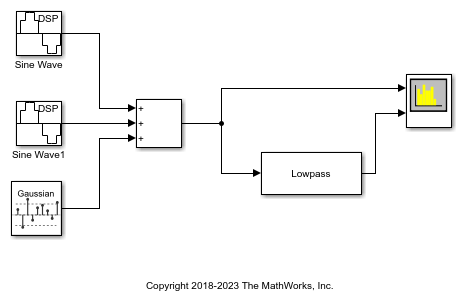
使用 get_param 函数访问 Spectrum Analyzer 模块的配置属性。
sablock = 'spectrumanalyzer_measurements/Spectrum Analyzer'; cfg = get_param(sablock,'ScopeConfiguration');
启用测量数据
要获取测量值,请将 Enabled 属性设置为 true。标注峰值测量值。
cfg.CursorMeasurements.Enabled = true; cfg.ChannelMeasurements.Enabled = true; cfg.DistortionMeasurements.Enabled = true; cfg.PeakFinder.Enabled = true; cfg.PeakFinder.LabelPeaks = true;
对模型进行仿真
运行模型。Spectrum Analyzer 模块将原始频谱与滤波后的频谱进行比较。
sim(model)

频谱分析仪窗口底部的面板显示您已启用的测量。
使用 getMeasurementsData 函数
使用 getMeasurementsData 函数以编程方式获取测量值。
data = getMeasurementsData(cfg)
data =
1×5 table
SimulationTime PeakFinder CursorMeasurements ChannelMeasurements DistortionMeasurements
______________ __________ __________________ ___________________ ______________________
{[99.9967]} 1×1 struct 1×1 struct 1×1 struct 1×1 struct
测量面板中显示的值与 data 中显示的值匹配。您可以编程方式访问 data 的各个字段来获得各种测量值。
比较峰值
以比较峰值为示例。验证 data.PeakFinder 获得的峰值与频谱分析仪窗口中的值是否匹配。
peakvalues = data.PeakFinder.Value frequencieskHz = data.PeakFinder.Frequency/1000
peakvalues =
26.9620
26.2688
-4.5790
frequencieskHz =
15.0015
1.0049
9.6038
扩展示例
Spectrum Analyzer Measurements
Use the Spectrum Analyzer block for harmonic distortion measurements (such as THD, SNR, SINAD, and SFDR), third-order intermodulation (TOI) distortion measurements, and adjacent channel power ratio (ACPR) measurements. The example also shows you how to view time-varying spectra by using a spectrogram and automatic peak detection. The example includes five amplifier models, with each model representing a typical setup to perform one of the measurements.
(DSP System Toolbox)
High Resolution Spectral Analysis in Simulink
Perform spectral estimation in Simulink® using the filter bank method, and compare the performance with the Welch's averaged modified periodogram method.
(DSP System Toolbox)
端口
输入
连接要可视化的信号。您最多可以有 96 个输入端口。输入信号必须具有以下特性:
信号域 - 频域或时域信号。
类型 - 离散信号。
数据类型 - Simulink 支持的任何数据类型。请参阅 Simulink 支持的数据类型。
Spectrum Analyzer 模块支持可变大小输入信号,即信号的帧大小可以在仿真期间改变。当信号帧大小改变时,示波器使用的采样率也会相应改变改,进而更新频谱显示的频率跨度。
Spectrum Analyzer 模块接受定点输入,但将其转换为 double 进行显示。
在您启用以下输入端口之一之前,此端口是未命名的:
F
RBW
VBW
(自 R2024a 起)
数据类型: single | double | int8 | int16 | int32 | int64 | uint8 | uint16 | uint32 | uint64 | fixed point
复数支持: 是
指定频率,以 Hz 为单位。频率向量必须为包含 2 个或更多元素的有限、单调递增的列向量。频率向量点的数量必须等于输入帧大小。您也可以使用估计选项卡上的频率(Hz) 参数来指定频率。
依赖关系
要启用此端口,请进行如下设置:
将估计选项卡上的输入域参数设置为频率。
将估计选项卡上的频率(Hz) 参数设置为输入端口。
数据类型: single | double | int8 | int16 | int32 | int64 | uint8 | uint16 | uint32 | uint64 | Boolean | fixed point
指定通过此端口的分辨率带宽,以 Hz 为单位。RBW 定义可由示波器解析的最小正频率。您也可以使用估计选项卡上的 RBW (Hz) 参数来指定 RBW 值。
依赖关系
要启用此端口,请将估计选项卡上的 RBW (Hz) 参数设置为输入端口。
数据类型: single | double | int8 | int16 | int32 | int64 | uint8 | uint16 | uint32 | uint64 | Boolean | fixed point
指定通过此端口的视频带宽,以 Hz 为单位。视频带宽是低通滤波器的带宽,示波器在显示信号之前使用视频带宽对信号中的噪声求平均值或进行平滑处理。您也可以使用估计选项卡上的 VBW (Hz) 参数来指定 VBW 值。
依赖关系
要启用此端口,请进行如下设置:
将估计选项卡上的输入域参数设置为时间。
将估计选项卡上的平均值计算方法参数设置为 VBW。
将估计选项卡上的 VBW (Hz) 参数设置为输入端口。
数据类型: single | double | int8 | int16 | int32 | int64 | uint8 | uint16 | uint32 | uint64 | Boolean | fixed point
参数
“示波器”选项卡
视图
将频谱类型设置为以下值之一:
功率 - 频谱分析仪显示功率谱。
功率密度 - 频谱分析仪显示功率谱密度。功率谱密度是归一化为 1 赫兹带宽的频谱的平方幅值。
RMS - 频谱分析仪显示均方根频谱。使用此选项查看电压或电流信号的频率。
可调: Yes
依赖关系
要启用此参数,请将估计选项卡上的输入域参数设置为时间。
编程用法
模块参数:SpectrumType |
| 类型:字符向量或字符串标量 |
带宽
将示波器使用的采样率(以 Hz 为单位)指定为下列值之一:
继承 - 使用此选项指定与输入信号相同的采样率。
正标量 - 指定的采样率必须至少是输入信号采样率的两倍。否则,在示波器中可视化信号时,由于存在混叠,您可能会看到意外的行为。
当信号帧大小改变时,示波器使用的采样率也会相应改变改,进而更新频谱显示的频率跨度。
要在状态栏上显示采样率,请点击状态栏中的 图标并选择采样率。
编程用法
模块参数:SampleRate、SampleRateSource |
类型:double |
可调: Yes
将要应用于频率轴(x 轴)的偏移量(以 Hz 为单位)指定为下列值之一:
标量 - 对所有通道应用相同的频率偏移。
向量 - 为每个通道应用特定的频率偏移。向量长度必须等于输入通道的数量。
总跨度必须在奈奎斯特频率间隔内。根据您的跨度(Hz) 参数的设置,您可以用不同方式控制总跨度。
可调: Yes
编程用法
模块参数:FrequencyOffset |
类型:double |
配置 > 频谱分析仪设置 ( )
)
模块的输入端口数,指定为 1 到 96 之间的整数。要更改输入端口的数量,请将新输入信号线拖至模块,模块会自动创建新端口。
编程用法
模块参数:NumInputPorts |
| 类型:字符向量或字符串标量 |
| 值:1 到 96 之间的标量 |
选择此参数以在运行仿真时自动打开频谱分析仪窗口。
编程用法
模块参数:OpenAtSimulationStart |
| 类型:逻辑 |
自 R2024b 起
将示波器显示画面中数值的精度指定为范围 [1, 15] 内的正整数。
可调: Yes
将频谱显示中的 y 轴标签指定为字符向量或字符串标量。要显示信号单位,请在标签中添加 (%<SignalUnits>)。当仿真开始时,Simulink 用与信号相关联的单位替换 (%SignalUnits)。
例如,对于以米/秒为单位的速度信号,输入
Velocity (%<SignalUnits>)
可调: Yes
依赖关系
要启用此参数,请在示波器选项卡中选择频谱。
编程用法
模块参数:YLabel |
| 类型:字符向量或字符串标量 |
将频谱分析仪显示中的 y 轴范围指定为 [ymin ymax] 形式的二元素数值向量。y 轴范围的单位取决于频谱选项卡中的频谱单位。
可调: Yes
依赖关系
要启用此参数,请在示波器选项卡中选择频谱。
编程用法
模块参数:YLimits |
类型:double |
指定显示标题。输入 %<SignalLabel> 以将 Simulink 模型中的信号标签用作坐标区标题。
可调: Yes
编程用法
模块参数:Title |
| 类型:字符向量或字符串 |
选中此复选框以在频谱分析仪显示中显示网格。
可调: Yes
编程用法
模块参数:ShowGrid |
类型:logical |
为频谱图选择一个有效的颜色图名称,或输入一个三列矩阵,其值在定义 RGB 三元组的范围 [0,1] 内。有关颜色图的详细信息,请参阅 colormap。
可调: Yes
依赖关系
要启用此参数,请在示波器选项卡中选择频谱图。
编程用法
模块参数:Colormap |
| 类型:字符向量或字符串标量 |
将频谱图的颜色范围指定为 [colorMin colorMax] 形式的一个二元素数值向量。颜色范围的单位直接取决于频谱图选项卡中的频谱单位。
可调: Yes
依赖关系
要启用此参数,请在示波器选项卡中选择频谱图。
编程用法
模块参数:ColorLimits |
类型:double |
指定在频谱显示中显示线图还是针状图。
您可以单独控制每个通道的绘图类型。要控制每个通道的绘图类型,请选择通道并相应地设置绘图类型参数。 (自 R2025a 起)
可调: Yes
依赖关系
要启用此参数,请进行如下设置:
在示波器选项卡中选择频谱。
在频谱选项卡中选中普通轨迹复选框。
编程用法
模块参数:PlotType |
| 类型:字符向量或字符串标量 |
将刻度、标签、标题和示波器测量值的字体大小指定为正标量。
可调: Yes
编程用法
模块参数:- |
| 类型:double |
指定示波器图窗中的背景颜色。
可调: Yes
指定坐标区的背景颜色。
可调: Yes
指定图例中标签、网格和通道名称的颜色。
可调: Yes
指定要修改其可见性、线条颜色、宽度和标记属性的通道。
可调: Yes
选中此复选框以显示您选中的通道。如果清除此复选框,所选通道将不再可见。您也可以点击图例中的信号名称来控制其可见性。有关详细信息,请参阅Legend (DSP System Toolbox)。
可调: Yes
指定所选通道的线型。
可调: Yes
指定所选通道的线宽。
可调: Yes
为所选通道指定一个数据点标记。此参数与绘图的 Marker 属性相似。您可以从下拉列表中选择任何标记符号。
可调: Yes
为所选通道指定线条颜色。
可调: Yes
配置
点击图例按钮以使频谱分析仪显示信号图例。图例显示模型中的信号名称。对于具有多个通道的信号,示波器会在信号名称后附加通道索引。连续信号的名称前面带有直线条,离散信号的名称前面带有楼梯形线条。
您可以使用图例控制哪些信号可见。要隐藏信号,请在示波器图例中,点击信号名称。要显示信号,请再次点击信号名称。您也可以使用频谱分析仪设置 ( ) 中的可见参数来控制哪个信号可见。
) 中的可见参数来控制哪个信号可见。
要仅显示一个信号并隐藏所有其他信号,请右键点击希望示波器显示的信号的名称。要显示所有信号,请按 Esc。
注意
图例仅显示前 20 个信号。您无法查看或控制图例中的任何其他信号。
可调:是
依赖关系
要启用图例,请在示波器选项卡中选择频谱。
编程用法
模块参数:ShowLegend |
类型:logical |
当您选择颜色栏按钮时,频谱分析仪会显示颜色栏。
可调: Yes
依赖关系
要启用颜色栏按钮,请在示波器选项卡中选择频谱图。
编程用法
模块参数:ShowColorbar |
类型:logical |
通过在布局网格中选择适当的配置,垂直或水平堆叠坐标区。
可调: Yes
依赖关系
要启用布局,请在示波器选项卡中选择频谱和频谱图。
编程用法
模块参数:AxesLayout |
| 类型:字符向量或字符串标量 |
共享
点击此按钮以将示波器显示画面复制到剪贴板。您可以通过选择复制到剪贴板下拉菜单中的保留颜色来保留显示画面中的颜色。
当您使用示波器选项卡 > 共享部分中的复制到剪贴板和打印选项将显示画面复制到剪贴板时,请选择此参数以便示波器保留颜色。
要访问保留颜色,请点击复制到剪贴板的下拉箭头。
可调: Yes
点击此按钮以将示波器显示画面保存为图像或 PDF,或打印显示画面。
估计选项卡
域
要可视化的输入信号的域。如果可视化时域信号,示波器会根据您在估计方法参数中指定的算法将信号变换为频谱。
编程用法
模块参数:InputDomain |
| 类型:字符向量或字符串标量 |
将确定显示画面的 x 轴的频率向量设置为以下值之一:
自动 - 示波器根据输入的长度计算频率向量。有关详细信息,请参阅频率向量。
输入端口 - 在模块的频率输入端口上指定频率向量。
自定义向量 - 将自定义向量指定为频率向量。自定义向量的长度必须等于输入信号的帧大小。
可调: Yes
依赖关系
要启用此参数,请将输入域设置为频率。
编程用法
模块参数:FrequencyVectorSource、FrequencyVector |
类型:字符向量、字符串标量、double |
选择频域输入的单位。当您在估计选项卡的频谱单位参数中选择不同显示单位时,此参数使频谱分析仪能够缩放频率数据。
可调: Yes
依赖关系
要启用此参数,请将输入域设置为频率。
编程用法
模块参数:InputUnits |
| 类型:字符向量或字符串标量 |
频率分辨率
选择以下频谱估计方法之一:
滤波器组 - 使用分析滤波器组来估计功率谱。与韦尔奇方法相比,此方法具有更低的本底噪声、更好的频率分辨率、更低的频谱泄漏,并且每次更新需要更少的采样。
韦尔奇 - 使用韦尔奇平均修正周期图方法。
有关这些方法的更多详细信息,请参阅算法。
可调: Yes
依赖关系
要使用此参数,请将输入域设置为时间。
编程用法
模块参数:Method |
| 类型:字符向量或字符串标量 |
自 R2024a 起
将频谱分析仪的频率分辨率方法指定为以下选项之一:
RBW - RBW (Hz) 参数控制分析器的频率分辨率(以 Hz 为单位)。
频带数 - 仅当您将估计方法设置为滤波器组时适用。FFT 长度参数控制频率分辨率。
窗长度 - 仅当您将估计方法设置为韦尔奇时适用。窗长度参数控制频率分辨率。
可调: Yes
依赖关系
要启用此参数,请将输入域设置为时间。
编程用法
模块参数:FrequencyResolutionMethod |
| 类型:字符向量或字符串标量 |
将原型低通滤波器的锐度指定为范围 [0,1] 内的非负实数标量。
增大滤波器锐度可减少频谱泄漏,并提供更准确的功率读数。
可调: Yes
依赖关系
要启用此参数,请将估计方法设置为滤波器组。
编程用法
模块参数:FilterSharpness |
类型:double |
指定分辨率带宽,以 Hz 为单位。此参数定义示波器可以解析的最小正频率。默认情况下,此参数设置为自动。在这种情况下,频谱分析仪会确定适当的值,以确保在指定的频率跨度内有 1024 个 RBW 间隔。
如果您将此参数设置为输入端口,您可以通过模块上的输入端口指定 RBW 值。
如果将此参数设置为数值,则该值必须在指定的频率跨度内至少允许两个 RBW 间隔。换句话说,总频率跨度与 RBW 之比必须大于 2:
要在状态栏上显示此属性,请点击状态栏中的 图标并选择 RBW。
编程用法
模块参数:RBWSource、RBW |
类型:字符向量、字符串标量、double |
可调: Yes
自 R2024a 起
将窗长度(以采样为单位)指定为大于 2 的整数。模块使用窗长度来计算频谱估计值。此参数控制频率分辨率。
可调: Yes
依赖关系
要启用此参数,请进行如下设置:
将估计方法设置为韦尔奇。
将分辨率方法设置为窗长度。
编程用法
模块参数:WindowLength |
类型:double |
自 R2024a 起
您可以将 FFT 长度设置为以下选项之一:
自动 - FFT 长度的值取决于频率分辨率方法的设置。各种设置如下:
如果将分辨率方法设置为 RBW,则 FFT 长度等于每次更新的采样数 Nsamples。有关 Nsamples 的更多详细信息,请参阅“算法”部分。
如果将分辨率方法设置为窗长度,则 FFT 长度等于您在窗长度参数中指定的值或 1024(以较大者为准)。
如果将分辨率方法设置为频带数,则 FFT 长度等于输入帧大小(行数)。
正整数 - FFT 点数等于您在
FFTLength属性中指定的值。
可调: Yes
依赖关系
要启用此参数,请进行如下设置:
将估计方法设置为韦尔奇。
将估计方法设置为滤波器组,并将分辨率方法设置为频带数。
编程用法
模块参数: |
类型:字符向量或字符串标量 double |
求平均值
将平滑方法指定为以下方法之一:
VBW - 视频带宽方法。该模块使用低通滤波器来平滑轨迹并降低噪声。使用 VBW (Hz) 参数指定视频带宽 (VBW) 值。
指数 - 采样的加权平均值。该模块计算由指数衰减遗忘因子加权的采样的平均值。使用遗忘因子参数指定加权遗忘因子。
滚动 - 最后 Q 个采样的滚动平均值。使用频谱平均值参数指定 Q。 (自 R2025a 起)
有关平均值计算方法的详细信息,请参阅平均值计算方法。
可调: Yes
依赖关系
要启用此参数,请将输入域设置为时间。
编程用法
模块参数:AveragingMethod |
| 类型:字符向量或字符串标量 |
将视频带宽指定为以下值之一:S
Auto- 频谱分析仪调整 VBW,使等效遗忘因子为 0.9。输入端口 - 在模块的 VBW 输入端口上指定频率向量。
正标量 - 指定正标量。频谱分析仪使用此值调整 VBW。您指定的值必须小于或等于采样率(Hz)/2。
有关视频带宽方法的更多详细信息,请参阅平均值计算方法。
频谱分析仪在显示画面底部的状态栏中显示 VBW 值。要显示 VBW 值,请点击状态栏中的 图标并选择 VBW。
依赖关系
要启用此参数,请进行如下设置:
将输入域设置为时间。
将平均值计算方法设置为 VBW。
编程用法
模块参数:VBWSource、VBW |
类型:double |
可调: Yes
将指数加权平均值计算方法的遗忘因子指定为范围 [0,1] 内的标量。
可调: Yes
依赖关系
要启用此参数,请进行如下设置:
将输入域设置为时间。
将平均值计算方法设置为指数。
编程用法
模块参数:ForgettingFactor |
类型:double |
自 R2025a 起
将频谱平均值的数量 Q 指定为正整数。
频谱分析仪通过计算最后 Q 个功率谱估计值的滚动平均值来计算当前功率谱估计值。
依赖关系
要启用此参数,请进行如下设置:
将输入域设置为时间。
平均值计算方法是滚动。
编程用法
模块参数:SpectralAverages |
类型:double |
数据类型: double
频率选项
将频率跨度模式指定为以下模式之一:
全频率 - 频谱分析仪计算并绘制整个奈奎斯特频率间隔内的频谱。
跨度和中心频率 - 频谱分析仪计算并绘制由跨度(Hz) 和中心频率(Hz) 参数指定的区间内的频谱。
开始和停止频率 - 频谱分析仪计算并绘制由开始频率(Hz) 和停止频率(Hz) 参数指定的区间内的频谱。
可调: Yes
依赖关系
要启用此参数,请将输入域设置为时间。
编程用法
模块参数:FrequencySpan |
| 类型:字符向量或字符串标量 |
指定频谱分析仪计算和绘制频谱的频率跨度(以 Hz 为单位)。由此参数和中心频率(Hz) 参数定义的总跨度必须在奈奎斯特频率间隔内。此参数定义频谱分析仪窗口中频数轴上显示的值范围。
可调: Yes
依赖关系
要启用此参数,请进行如下设置:
将输入域设置为时间。
将频率跨度设置为跨度和中心频率。
编程用法
模块参数:Span |
类型:double |
指定频谱分析仪计算和绘制频谱的频率跨度(以 Hz 为单位)的中心。使用此参数和跨度(Hz) 参数来定义以中央频率为中心的频率跨度。此参数定义频谱分析仪窗口中频率轴的中点。
可调: Yes
依赖关系
要启用此参数,请进行如下设置:
将输入域设置为时间。
将频率跨度设置为跨度和中心频率。
编程用法
模块参数:CenterFrequency |
类型:double |
指定频谱分析仪计算和绘制频谱的频率区间的开始频率(以 Hz 为单位)。由此参数和停止频率(Hz) 参数定义的总跨度必须在奈奎斯特频率间隔内。此参数定义频谱分析仪窗口中频率轴最左边的值。
可调: Yes
依赖关系
要启用此参数,请进行如下设置:
将输入域设置为时间。
将频率跨度设置为开始和停止频率。
编程用法
模块参数:StartFrequency |
类型:double |
指定频谱分析仪计算和绘制频谱的频率区间的停止频率(以 Hz 为单位)。由此参数和开始频率(Hz) 参数定义的总跨度必须在奈奎斯特频率间隔内。此参数定义频谱分析仪窗口中频率轴最右边的值。
可调: Yes
依赖关系
要启用此参数,请进行如下设置:
将输入域设置为时间。
将频率跨度设置为开始和停止频率。
编程用法
模块参数:StopFrequency |
类型:double |
窗口选项
指定适用于频谱的加窗方法。加窗用于控制频谱估计中旁瓣的影响。您指定的窗口会影响达到分辨率带宽所需的窗长度以及每次更新所需的采样数。有关加窗的详细信息,请参阅加窗法 (Signal Processing Toolbox)。
您可以通过在窗参数中直接指定自定义窗函数名称来使用自己的频谱估计窗。
可调: Yes
依赖关系
要启用此参数,请进行如下设置:
将输入域设置为时间。
将估计方法设置为韦尔奇。
编程用法
模块参数:Window、CustomWindow |
| 类型:字符向量或字符串标量 |
将旁瓣衰减指定为大于或等于 45 的标量,以 dB 为单位。
可调: Yes
依赖关系
要启用此参数,请将窗设置为切比雪夫或凯塞。
编程用法
模块参数:SidelobeAttenuation |
类型:double |
将上一个和当前缓冲数据段之间的重叠百分比指定为范围 [0 100) 内的标量。这种重叠会产生一个窗段,示波器用它来计算频谱估计值。该值必须大于或等于零且小于 100。
可调: Yes
依赖关系
要启用此参数,请进行如下设置:
将输入域设置为时间。
将估计方法设置为韦尔奇。
编程用法
模块参数:OverlapPercent |
类型:double |
“测量”选项卡
注意
要访问相位噪声测量设置,您必须具备有效的 Mixed-Signal Blockset™ 许可证。
通道
需要获取测量值的通道,指定为范围 [1 N] 内的正整数,其中 N 是输入通道的数量。
可调: Yes
依赖关系
要启用此参数,需要向示波器传递一些数据。
编程用法
请参阅 MeasurementChannel (DSP System Toolbox)。
游标
点击数据游标按钮以启用数据游标测量。每个游标沿信号跟踪一条垂直线。示波器显示游标之间方框中两个游标处信号的 x 和 y 值之间的差异。
可调: Yes
编程用法
请参阅Enabled (DSP System Toolbox)。
峰值
点击峰值查找器按钮以启用峰值查找器测量。图中每个最大值处会出现一个箭头,并且在示波器窗口的底部会出现一个峰值面板。
可调: Yes
编程用法
请参阅 Enabled (DSP System Toolbox)。
失真
相位噪声
点击相位噪声按钮以启用相位噪声测量。当您点击此按钮时,相位噪声轴和相位噪声面板将出现在示波器窗口中。
注意
要访问相位噪声测量设置,您必须具备有效的 Mixed-Signal Blockset 许可证。
可调: Yes
编程用法
请参阅 Enabled (DSP System Toolbox)。
选择此参数可绘制目标相位噪声曲线。您可以在目标相位噪声(dBc/Hz) 参数中指定此曲线。
可调: Yes
编程用法
请参阅 PlotTargetPhaseNoise (DSP System Toolbox)。
将目标相位噪声曲线(以 dBc/Hz 为单位)指定为与频率偏移(Hz) 向量长度相同的数值向量。
可调: Yes
依赖关系
要启用此参数,请选择绘制目标相位噪声参数。
编程用法
请参阅 TargetPhaseNoise (DSP System Toolbox)。
选择此参数可在绘图上标注测量的相位噪声。当您选择此参数时,频谱分析仪会在绘图上将测量的相位噪声值标注为 SN1、SN2 等。
可调: Yes
编程用法
请参阅 LabelPhaseNoise (DSP System Toolbox)。
频谱选项卡
注意
当您在示波器选项卡中选择频谱时,此选项卡出现。
跟踪选项
选中此复选框可启用双边频谱视图。在此视图中,频谱分析仪同时显示负频率和正频率。当输入信号为复数值时,必须选择此参数。如果清除此复选框,则频谱分析仪只显示具有正频率的单边频谱。在这种情况下,输入信号数据必须为实数值。
当您清除此复选框时,频谱分析仪使用功率折叠。y 轴值的振幅是选择该参数时的两倍,但在 0 和奈奎斯特频率处除外。单边功率谱密度 (PSD) 包含从 DC 到奈奎斯特速率一半的频率区间内的信号总功率。有关详细信息,请参阅 pwelch (Signal Processing Toolbox)。
可调: Yes
编程用法
模块参数:PlotAsTwoSidedSpectrum |
类型:logical |
选中此复选框时,频谱分析仪会计算并绘制功率谱估计值。频谱分析仪通过对几个频谱估计值求平均值来执行平滑操作,并继续其频谱估计,即使您清除了此参数也是如此。
可调: Yes
依赖关系
要清除此复选框,请首先选中最大值保持轨迹或最小值保持轨迹参数。
要启用此参数,请在示波器选项卡中选择频谱。
编程用法
模块参数:PlotNormalTrace |
类型:logical |
选中此复选框可使频谱分析仪绘制所有估计值的最大频谱值。频谱分析仪通过保留所有功率谱估计值的最大值来计算每个频率 bin 的最大值保持频谱。清除此复选框时,频谱分析仪会重置其最大值保持计算。
可调: Yes
依赖关系
要启用此参数,请在示波器选项卡中选择频谱。
编程用法
模块参数:PlotMaxHoldTrace |
类型:logical |
选中此复选框可使频谱分析仪绘制所有估计值的最小频谱值。频谱分析仪通过保留所有功率谱估计值的最小值来计算每个频率 bin 的最小值保持频谱。清除此复选框时,频谱分析仪会重置其最小值保持计算。
可调: Yes
依赖关系
要启用此参数,请在示波器选项卡中选择频谱。
编程用法
模块参数:PlotMinHoldTrace |
类型:logical |
刻度
将要显示频率的刻度指定为线性或对数。当频率跨度包含负频率值时,不能选择对数选项。
可调: Yes
依赖关系
要将频率刻度设置为对数,请清除频谱或频谱图选项卡(如果已启用)中跟踪选项部分的双边频谱复选框。如果您选中双边频谱复选框,则频率刻度参数将设置为线性。
编程用法
模块参数:FrequencyScale |
| 类型:字符向量或字符串标量 |
指定频谱分析仪在计算功率值时使用的参考负载,以欧姆为单位。
可调: Yes
依赖关系
要启用此参数,请进行如下设置:
频谱类型为功率或功率密度。
编程用法
模块参数:ReferenceLoad |
类型:double |
将频谱分析仪显示功率值的单位指定为下列值之一:
dBm
dBFS
dBuV (自 R2023b 起)
dBV
dBW
Vrms
瓦茨
dBm/Hz
dBW/Hz
dBFS/Hz
Watts/Hz
自动
可调: Yes
依赖关系
可用的单位取决于您在示波器选项卡中为频谱参数选择的值。
| “估计”选项卡 >“输入域”参数 | “示波器”选项卡 >“频谱”选项 | 可用单位 |
|---|---|---|
| 时间 | 功率 | dBm、dBW、dBFS、Watts |
| 功率密度 | dBm/Hz、dBW/Hz、dBFS/Hz、Watts/Hz | |
| RMS | dBuV (自 R2023b 起)、dBV、Vrms | |
| 频率 | ― | Auto、dBm、dBuV (自 R2023b 起)、dBV、dBW、Vrms、Watts |
如果您将输入域参数设置为频率,将频谱单位参数设置为自动,频谱分析仪会假定频谱单位等于在估计选项卡 > 输入单位参数中指定的输入单位。如果将输入域参数设置为时间并将频谱单位参数设置为自动以外的任何选项,频谱分析仪会将在输入单位参数中指定的单位转换为在频谱单位参数中指定的单位。
编程用法
模块参数:SpectrumUnits |
| 类型:字符向量或字符串标量 |
分贝满刻度 (dBFS) 单位中的满刻度。默认情况下,频谱分析仪使用频谱的全刻度。为 dBFS 满刻度指定正实数标量。
可调: Yes
依赖关系
要启用此参数,请进行如下设置:
在示波器选项卡中,将频谱类型设置为功率或功率密度。
在估计选项卡中,将输入域设置为时间。
在频谱选项卡中,将频谱单位设置为 dBFS 或 dBFS/Hz(当频谱类型设置为功率密度时)。
编程用法
模块参数:FullScale |
类型:double |
“频谱图”选项卡
注意
当您在示波器选项卡中选择频谱图时,此选项卡会出现。
通道
选择应用频谱图设置的通道。
可调: Yes
依赖关系
要启用此参数,请在示波器选项卡中选择频谱图。
编程用法
模块参数:SpectrogramChannel |
类型:字符向量、字符串标量、double |
时间选项
时间分辨率是用于计算频谱图线的数据量(以秒为单位)。可达到的最小分辨率是计算单个频谱估计值所花费的时间量。根据当前频谱分析仪设置,工具提示会显示可达到的最小分辨率。
当您将 RBW (Hz) 和时间分辨率(秒) 设置为自动时,频谱分析仪会调整 RBW 值,使一个频率跨度内有 1024 个 RBW 间隔,并将时间分辨率设置为 1/RBW。
当您将 RBW (Hz) 设置为自动并将时间分辨率(秒) 设置为正标量时,时间分辨率将成为主要控制项,RBW 将设置为 1/时间分辨率(秒) Hz。
当您将 RBW (Hz) 设置为正标量并将时间分辨率(秒) 设置为自动时,RBW 将成为主要控制项,时间分辨率设置为 1/RBW (Hz) 秒。
当您将 RBW (Hz) 和时间分辨率(秒) 设置为正值时,时间分辨率必须等于或大于由 1/RBW (Hz) 定义的可达到的最小时间分辨率。将若干个频谱估计值组合为一条频谱图线可获得所需的时间分辨率。插值法可用于获得并非 1/RBW (Hz) 整数倍的时间分辨率值。
可调: Yes
依赖关系
要启用此参数,请在示波器选项卡中选择频谱图,并在估计选项卡中将输入域设置为时间。
编程用法
模块参数:TimeResolutionSource、TimeResolution |
类型:字符向量、字符串标量、double |
频谱分析仪显示频谱图的时间跨度,指定为以秒为单位的正标量。时间跨度是所需频谱线数和时间分辨率的乘积。当您将此参数设置为自动时,频谱图会在任何给定时间显示 100 条频谱图线。否则,频谱图将使用您在此参数中指定的持续时间。您指定的时间跨度必须至少是频谱更新所需采样数持续时间的两倍。
可调: Yes
依赖关系
要启用此参数,请在示波器选项卡中选择频谱图,并在估计选项卡中将输入域设置为时间。
编程用法
模块参数:TimeSpanSource、TimeSpan |
类型:字符向量、字符串标量、double |
有关 Two-Sided Spectrum 的详细信息,请参阅频谱选项卡 > 跟踪选项。
“频谱模板”选项卡
注意
当您在示波器选项卡中选择频谱并将频谱类型设置为功率或功率密度时,此选项卡会出现。
视图
选择上模板可在频谱图中显示上模板。频谱模板面板出现在频谱分析仪窗口的底部,它显示模板详细信息,如模板成功的次数、模板失败的次数、导致模板失败的通道等。
使用上限参数可指定上模板。如果整个频谱图位于上模板,则上模板显示为绿色。在所有其他情况下,上模板显示为红色。
可调: Yes
编程用法
请参阅 EnabledMasks (DSP System Toolbox)。
选择下模板可在频谱图中显示下模板。频谱模板面板出现在频谱分析仪窗口的底部,它显示模板详细信息,如模板成功的次数、模板失败的次数、导致模板失败的通道等。
使用下限参数可指定下模板。如果整个频谱图位于下模板之上,则下模板显示为绿色。在所有其他情况下,下模板显示为红色。
可调: Yes
编程用法
请参阅 EnabledMasks (DSP System Toolbox)。
配置
将频谱模板上限指定为标量或两列矩阵。
如果 UpperMask 是标量,模板上限对频谱分析仪中指定的所有频率使用相同的功率值。
如果指定矩阵,第一列包含频率值 (Hz),它对应于 x 轴值。第二列包含功率值,对应于相关联的 y 轴值。
要对功率和频率值应用偏移,请使用参考电平(dBr) 和频率偏移(Hz) 参数。
可调: Yes
编程用法
请参阅 UpperMask (DSP System Toolbox)。
将频谱模板下限指定为标量或两列矩阵。
如果 LowerMask 是标量,模板下限对频谱分析仪中指定的所有频率使用相同的功率值。
如果指定矩阵,第一列包含频率值 (Hz),它对应于 x 轴值。第二列包含功率值,对应于相关联的 y 轴值。
要对功率和频率值应用偏移,请使用参考电平(dBr) 和频率偏移(Hz) 参数。
可调: Yes
编程用法
请参阅 LowerMask (DSP System Toolbox)。
将模板功率值的参考电平指定为数值标量,或将其设置为频谱峰值。
当您将参考电平(dBr) 设置为标量值时,频谱分析仪会将此值用作频谱分析仪上模板和下模板的功率值(以 dBr 为单位)的参考。参考电平应与频谱选项卡中的频谱单位参数具有相同的单位。
当您将参考电平(dBr) 设置为频谱峰值时,频谱分析仪将使用频谱模板选项卡中通道的当前频谱峰值作为参考功率值。
可调: Yes
编程用法
请参阅 ReferenceLevel (DSP System Toolbox) 和 CustomReferenceLevel (DSP System Toolbox)。
选择频谱分析仪用于确定模板参考电平的输入通道。当您将参考电平(dBr) 参数设置为频谱峰值时,此通道中的频谱峰值成为模板参考电平。
可调: Yes
依赖关系
要启用此参数,请将参考电平(dBr) 设置为频谱峰值并在示波器上显示一些数据。
编程用法
请参阅 SelectedChannel (DSP System Toolbox)。
将频率偏移指定为有限数值标量,以 Hz 为单位。使用此值,频谱分析仪将偏移上模板和下模板参数中的频率值。
可调: Yes
编程用法
请参阅 MaskFrequencyOffset (DSP System Toolbox)。
通道测量值选项卡
注意
当您在示波器选项卡中选择频谱时,此选项卡出现。
通道
指定频谱分析仪计算和显示占用带宽和相邻通道功率比的通道,占用带宽和相邻通道功率比显示为范围 [1 N] 内的正整数,其中 N 是输入通道的数量。
可调: Yes
依赖关系
要启用此参数,需要向示波器传递数据。
编程用法
请参阅 MeasurementChannel (DSP System Toolbox)。
通道测量值
指定频谱分析仪将占用带宽计算为正标量的功率百分比。
可调: Yes
依赖关系
要启用此参数,请将类型设置为占用带宽。
编程用法
请参阅 PercentOccupiedBW (DSP System Toolbox)。
频率选项
将频率跨度模式指定为以下模式之一:
跨度和中心频率 - 在跨度(Hz) 中指定的频率范围内和在中心频率(Hz) 中指定的频率值附近进行测量。
开始和停止频率 - 在频率范围 [开始频率(Hz), 停止频率(Hz)] 内进行测量。
可调: Yes
编程用法
请参阅 FrequencySpan (DSP System Toolbox)。
将频谱分析仪计算通道测量值的频率跨度指定为正标量,以 Hz 为单位。
可调: Yes
依赖关系
要启用此参数,请将频率跨度设置为跨度和中心频率。
编程用法
请参阅 Span (DSP System Toolbox)。
对象计算通道测量值的跨度的中心频率,指定为实数标量,以 Hz 为单位。
可调: Yes
依赖关系
要启用此参数,请将频率跨度设置为跨度和中心频率。
编程用法
请参阅 CenterFrequency (DSP System Toolbox)。
指定频谱分析仪计算通道测量值的开始频率,以 Hz 为单位。
可调: Yes
依赖关系
要启用此参数,请将频率跨度设置为开始和停止频率。
编程用法
请参阅 StartFrequency (DSP System Toolbox)。
指定频谱分析仪计算通道测量值的停止频率,以 Hz 为单位。
可调: Yes
依赖关系
要启用此参数,请将频率跨度设置为开始和停止频率。
编程用法
请参阅 StopFrequency (DSP System Toolbox)。
相邻通道
将相邻通道对组的数量指定为范围 [1, 12] 内的正整数。
可调: Yes
依赖关系
要启用此参数,请将类型设置为 ACPR。
编程用法
请参阅 NumOffsets (DSP System Toolbox)。
将相对于主通道中心频率的相邻通道频率指定为一个实数向量,其长度等于在对组数中指定的偏移量对数量。
可调: Yes
依赖关系
要启用此参数,请将类型设置为 ACPR。
编程用法
请参阅 ACPROffsets (DSP System Toolbox)。
将主通道和相邻通道的滤波器形状指定为无、RRC 或高斯。
可调: Yes
依赖关系
要启用此参数,请将类型设置为 ACPR。
编程用法
请参阅 FilterShape (DSP System Toolbox)。
将滚降因子指定为范围 [0, 1] 内的实数标量。
可调: Yes
依赖关系
要启用此参数,请将类型设置为 ACPR,并将滤波器形状设置为 RRC。
编程用法
请参阅 FilterCoeff (DSP System Toolbox)。
将带宽时间乘积指定为范围 [0, 1] 内的实数标量。
可调: Yes
依赖关系
要启用此参数,请将类型设置为 ACPR,并将滤波器形状设置为高斯。
编程用法
请参阅 FilterCoeff (DSP System Toolbox)。
仅属性检查器
输入通道名称,指定为字符向量、字符串或数组。名称显示在图例、设置和测量面板中。如果不指定名称,示波器会将通道标记为 Channel 1、Channel 2 等。
示例: ["A","B"]
依赖关系
要查看通道名称,请在示波器选项卡中选择图例。
编程用法
模块参数:ChannelNames |
| 类型:字符向量元胞数组或字符串数组 |
Auto- 如果未指定标题和 Y 标签,示波器将最大化所有绘图。On- 示波器最大化所有绘图并隐藏标题和 Y 标签中的所有值。Off- 示波器不最大化绘图。
将鼠标悬停在频谱分析仪上方以查看最大化坐标区按钮 ![]() 。
。
可调:是
编程用法
模块参数:MaximizeAxes |
| 类型:字符向量或字符串标量 |
OnceAtStop- 在仿真完成后缩放 y 轴。Manual- 使用缩放 Y 轴范围工具栏按钮手动缩放 y 轴范围。Auto- 在仿真期间和仿真后缩放 y 轴范围。Updates- 在 更新次数 文本框中指定的时间步数(默认值为100)后缩放 y 轴。每次运行期间仅发生一次缩放。
可调: Yes
编程用法
模块参数:AxesScaling |
| 类型:字符向量或字符串标量 |
模块特性
数据类型 |
|
直接馈通 |
|
多维信号 |
|
可变大小信号 |
|
过零检测 |
|
详细信息
使用跟踪信号的垂直波形游标测量信号值。
当您点击频谱分析仪的测量选项卡中的数据游标按钮时,频谱显示会在每个信号上显示垂直游标。每个游标沿信号跟踪一条垂直线。示波器显示游标之间方框中两个游标处信号的 x 和 y 值之间的差异。
要启用游标测量,请点击测量选项卡中的数据游标按钮。仅当频谱分析仪的显示画面中有至少一个信号时,游标才会出现。
您可以使用鼠标左右移动垂直游标。
在测量选项卡中,点击数据游标下拉箭头选择以下选项之一:
吸附到数据 - 将游标定位在信号数据点上。
锁定游标间距 - 锁定两个游标之间的频率差。
要以编程方式修改游标测量值,请参阅 CursorMeasurementsConfiguration (DSP System Toolbox) 对象。
计算并在示波器显示画面中显示峰值。
当您点击频谱分析仪的测量选项卡中的峰值查找器按钮时,图上每个最大值处会出现一个箭头,示波器窗口底部会出现峰值面板。频谱分析仪根据示波器当前显示的输入信号部分计算峰值,峰值面板显示峰值及出现峰值的频率。
测量选项卡中的峰值部分允许您指定希望示波器显示的峰值的数量、希望示波器检测峰值的最小高度、峰值之间的最小距离以及标注峰值。
频谱分析仪算法将峰值定义为局部最大值,下限值出现在峰值的任一侧。它不将端点视为峰值。有关该算法的详细信息,请参阅 findpeaks (Signal Processing Toolbox) 函数。
峰值对输入信号的任何单位都有效。每个测量值后的字母是对应国际单位制 (SI) 前缀的缩写,例如 m 表示 milli-。例如,如果输入信号以伏特为单位测量,测量值旁边的 m 表示该值以毫伏为单位。
要以编程方式修改峰值查找器测量值,请参阅 PeakFinderConfiguration (DSP System Toolbox) 对象。有关 UI 中这些设置的详细信息,请参阅Peaks (DSP System Toolbox)。
测量谐波失真和互调失真。
当您点击测量选项卡的失真部分中的失真按钮时,在频谱分析仪窗口底部会打开失真面板。此面板显示示波器当前显示的输入信号的谐波和失真测量值。测量选项卡中的失真部分允许您指定失真类型、谐波数量,甚至标注谐波。
注意
为了获得精确测量值,请确保基波信号(针对谐波)或主音(针对互调)大于任何杂散或谐波成分。为此,您可能需要调整频谱分析仪的分辨率带宽 (RBW)。请确保带宽足够低,能够将信号和谐波与杂散噪声含量隔离开来。一般情况下,您应设置 RBW 值,使正弦波峰值和本底噪声之间有至少 10 dB 的间隔。您可能还需要选择不同频谱窗来获得有效的测量值。
您可以将失真类型参数设置为以下值之一:
谐波 - 如果您的输入是单个正弦波,请选择谐波。
互调 - 如果您的输入是两个等幅正弦波,请选择互调。当示波器仅使用一小部分可用带宽时,互调可以帮助您确定失真。
有关如何计算失真测量值的信息,请参阅Distortion Measurements (DSP System Toolbox)。
当您将失真类型设置为谐波时,这些字段会出现在频谱分析仪窗口底部的谐波失真面板中。
H1 - 以 Hz 为单位的基频及其以 1 毫瓦为基准按分贝表示的测量功率值 (dBm)。
H2、H3... - 以 Hz 为单位的谐波频率及其按分贝表示的相对于载波的功率 (dBc)。如果谐波处于相同电平或超出基频,则降低输入功率。
THD - 总谐波失真。此值表示谐波 D 中的功率与基频 S 中的功率之比。如果噪声功率相对于谐波过高,则 THD 值不准确。在这种情况下,请降低分辨率带宽或选择不同频谱窗。
SNR - 信噪比 (SNR)。此值表示基频 S 的功率与所有非谐波成分 N(其中包括杂散信号)的功率之比,以相对于载波的分贝值 (dBc) 表示。
如果报告的 SNR 为
––,则表示信号的总非谐波成分低于整个信号的 30%。SINAD - 信噪失真比。此值表示基频 S 中的功率与所有其他内容(包括噪声 N 和谐波失真 D)的比值,按分贝表示,相对于载波 (dBc)。
SFDR - 无杂散动态范围 (SFDR)。此值表示基频 S 中的功率与最大杂散信号 R 的功率之比,无论它位于频谱中的哪个位置。最差的杂散信号可能是(也可能不是)原始信号的谐波。SFDR 表示可以与大干扰信号区分的信号的最小值。SFDR 包括谐波。
谐波失真测量自动定位最大的正弦分量(基波信号频率)。然后,它会计算信号中每个谐波的谐波频率和功率,并忽略任何 DC 分量。测量不包括频谱分析仪频率跨度之外的任何谐波。请调整您的频率跨度,使其包含所有需要的谐波。
注意
要查看最佳谐波,请确保您的基频设置足够高,能够解析谐波。然而,此频率也不应太高,以免发生混叠。为了最好地显示谐波失真,您的图不应显示“裙边”,裙边表示频率泄漏。本底噪声应可见。
为了获得更好的显示效果,请尝试使用旁瓣衰减较大的凯塞窗(例如,在 100 - 300 db 之间)。

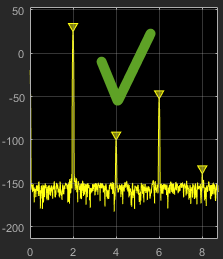
当您将失真类型设置为互调时,以下字段会出现在频谱分析仪窗口底部的互调失真面板中。
F1 - 一阶基频下限。
F2 - 一阶基频上限。
2F1 - F2 - 三次谐波的互调乘积下限。
2F2 - F1 - 三次谐波的互调乘积上限。
TOI - 三阶截断点。如果噪声功率相对于谐波过高,TOI 值将会不准确。在这种情况下,您应降低分辨率带宽或选择不同频谱窗。如果 TOI 与输入双音信号具有相同的振幅,则降低该输入信号的功率。
互调失真测量会自动定位基频和一阶频率(F1 和 F2)。然后,它计算三阶互调乘积的频率(2F1−F2 和 2F2−F1)。
要以编程方式修改失真测量值,请参阅 DistortionMeasurementsConfiguration (DSP System Toolbox) 对象。有关 UI 中这些设置的详细信息,请参阅Distortion (DSP System Toolbox)。
测量占用带宽或相邻通道功率比 (ACPR)。
当您点击通道测量选项卡中的通道测量按钮时,会在频谱分析仪窗口的底部打开通道测量面板。此面板显示占用带宽或相邻通道功率比测量值。在通道测量选项卡中,您可以指定占用带宽或 ACPR 设置、频率跨度、中心频率以及开始和停止频率。
您可以选择以下值作为通道测量类型:
占用带宽 - 占用带宽
ACPR - 主通道功率与相邻通道功率的比值
有关频谱分析仪如何计算占用带宽的更多详细信息,请参阅占用带宽。
占用带宽
当您将要计算和显示的通道测量类型设置为占用带宽时,这些字段会出现在示波器窗口底部的测量面板中。
通道功率 - 通道中的总功率
占用带宽 - 包含频谱总功率的指定占用带宽(%) 的带宽。
频率误差 - 占用频带的中心与通道的中心频率(中心频率(Hz))之间的差
ACPR
当您将要计算和显示的通道测量类型设置为 ACPR 时,这些字段会出现在示波器窗口底部的测量面板中。
下(相对功率(dBc)) - 下边带功率与主通道功率之比
上(相对功率(dBc)) - 上边带功率与主通道功率之比
要以编程方式修改通道测量值,请参阅 ChannelMeasurementsConfiguration (DSP System Toolbox) 对象。有关 UI 中这些设置的详细信息,请参阅通道测量值。
可视化频谱限值,并将频谱值与设定值进行比较。
向频谱分析仪添加上模板和下模板,以可视化频谱限值并将频谱值与设定值进行比较。要启用频谱模板选项卡,请在示波器选项卡中选择频谱。当您点击频谱模板选项卡中的上模板和下模板按钮时,会在频谱分析仪窗口的底部打开频谱模板面板。此面板提供有关模板的通过/失败统计量、当前失败或通过的模板名称以及导致失败的通道名称的信息。
您可以在频谱模板选项卡中修改模板设置。有关 UI 中这些设置的详细信息,请参阅频谱模板。要以编程方式修改通道测量值,请参阅 SpectralMaskConfiguration (DSP System Toolbox) 对象。
您可以使用 getSpectralMaskStatus (DSP System Toolbox) 函数检查频谱模板的状态。此函数提供模板成功或失败的次数、导致模板失败的通道名称等详细信息。
您甚至可以使用 MaskTestFailed 事件在每次模板失败时执行操作。要在模板失败时触发函数,请创建一个 MaskTestFailed 事件的侦听程序,并定义回调函数来触发它。有关使用事件的详细消息,请参阅事件。
在频谱分析仪中设置配置和样式设置。
要控制显示和标签、颜色和样式的设置,请点击频谱分析仪工具条的示波器选项卡中的设置 ( )。
)。
在打开的对话框中,您可以自定义频谱图的字体大小、图类型、y 轴属性以及频谱图的颜色图属性。您可以更改频谱图、背景、坐标区和标签的颜色,也可以更改线条属性。
当您查看频谱或频谱图时,您只能看到相关选项。有关这些选项的更多详细信息,请参阅配置 > 频谱设置 (DSP System Toolbox)。
使用显示控件缩放和平移坐标区。
要缩放绘图坐标区,可使用鼠标在坐标区中平移,并使用鼠标上的滚动按钮放大和缩小绘图。此外,您还可以使用当鼠标悬停在绘图窗口上方时出现的按钮。
 - 最大化坐标区,隐藏所有标签并插入坐标区值。
- 最大化坐标区,隐藏所有标签并插入坐标区值。 - 放大绘图。
- 放大绘图。 - 平移绘图。
- 平移绘图。 - 自动缩放坐标区以适应显示的数据。
- 自动缩放坐标区以适应显示的数据。
提示
如果您将平均值计算方法设置为 VBW 或指数,并且向数据中引入 NaN 或 Inf 值,则频谱显示为空白。要忽略 NaN 或 Inf 值,请执行以下操作:
在 MATLAB® 工具条的主页选项卡 > 环境部分中,点击设置 (
 )。
)。在设置对话框的工作区部分,选中计算统计量时忽略 NaN 复选框。
算法
当您选择滤波器组方法时,频谱分析仪使用一个分析滤波器组来估计功率谱。
该滤波器组将采样率为 fs 的宽带输入信号 x(n) 分成采样率为 fs/M 的多个窄带信号 y0(m)、y1(m)、…、yM-1(m)。
变量 M 表示滤波器组中频带的数量。在频谱分析仪中,M 等于达到指定 RBW 值所需的数据点数或 1024,以两者中较大者为准。有关分析滤波器组及其实现的详细信息,请参阅 dsp.Channelizer 对象中的More About (DSP System Toolbox)和Algorithm (DSP System Toolbox)部分。
频谱分析仪将宽带输入信号分成多个窄带后,使用以下方程计算每个窄频带的功率。每个 Zi 值均为该窄频带上的功率估计值。
L 是窄带信号 yi(m) 的长度,并且 i = 1、2、…、M - 1。
所有窄频带中的功率值(由 Zi 表示)构成 Z 向量。
频谱分析仪使用以下移动平均值方法之一对当前 Z 向量和之前的 Z 向量求平均值:视频带宽、指数加权或滚动。平均值运算的输出构成频谱估计值向量。有关这两种平均值计算方法的详细信息,请参阅平均值计算方法。
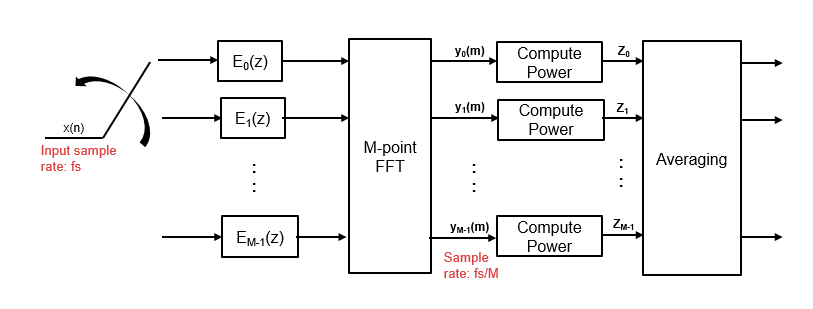
频谱分析仪使用您在 RBW (Hz) 参数或频带数参数中指定的值来确定输入帧长度。
如果您将分辨率方法指定为 RBW,并将 RBW (Hz) 设置为:
自动 - 频谱分析仪会确定适当的分辨率带宽,以确保在指定的频率跨度内有 1024 个 RBW 间隔。当您将 RBW (Hz) 设置为自动时,频谱分析仪会使用以下方程计算 RBW。
标量值 - 频谱分析仪使用以下公式计算采样数 Nsamples。
Fs 是在采样率(Hz) 属性中指定的输入信号的采样率。
您指定的 RBW 值必须在指定的频率跨度内有至少两个 RBW 间隔。总跨度与 RBW 之比必须大于 2。
span 是频谱分析仪计算和绘制频谱的频率跨度。要在示波器中查看跨度(Hz),请点击频谱分析仪工具条上的估计选项卡,并导航到频率选项部分。要启用此属性,请将频率跨度设置为跨度和中心频率。
当您将分辨率方法指定为频带数时,得到的 RBW 由下式给出:
当输入采样数不足以达到指定的分辨率带宽时,频谱分析仪会根据提供的输入采样数调整其 RBW 值,并显示一条与以下类似的消息。一旦您提供足够的输入采样,频谱分析仪就会删除此消息。

当您选择 韦尔奇 方法时,功率谱估计值是平均修正周期图。
频谱分析仪中的算法包括以下步骤:
模块将输入缓冲到包含 N 个点的数据段中。每个数据段分成 P 个重叠的数据段,每个数据段的长度为 M,重叠 D 个点。数据段可以表示为:
如果 D = M/2,则重叠为 50%。
如果 D = 0,则重叠为 0%。
将一个窗应用于时域中 P 个重叠数据段中的每个数据段。
如果您将分辨率方法设置为窗长度,则可以使用估计选项卡中的窗长度参数指定数据窗长度 Nwindow。
如果您将分辨率方法设置为 RBW,此算法将使用以下方程确定数据窗长度:。
然后,它将输入信号分割成若干加窗数据段。
大多数窗函数对集合中心数据的影响比对边缘数据的影响更大,这表示出现信息损失。为了减轻这种损失,单个数据集通常在时间上重叠。对于每个加窗段,通过计算离散傅里叶变换来计算周期图。然后计算结果的平方幅值,并将结果除以 M。
其中 U 是窗函数中功率的归一化因子,由下式给出:
您可以使用频谱分析仪工具条的估计选项卡中的窗参数来指定窗。
频谱分析仪计算并绘制功率谱、功率谱密度和使用修改的周期图估计器的 RMS。有关周期图方法的详细信息,请参阅
periodogram(Signal Processing Toolbox)。为了确定韦尔奇方法的功率谱估计值,频谱分析仪对最后 P 个数据段的周期图结果求平均值。与原始 N 点数据段相比,平均值法可减小方差。有关平均值法的详细信息,请参阅平均值计算方法。
频谱分析仪使用下式计算功率谱密度:
功率谱是功率谱密度与分辨率带宽的乘积,如以下公式所示。
频谱分析仪使用一定数量的采样来计算频谱估计值。此值与使用以下方程的分辨率带宽 (RBW) 直接相关:
其中,Op 是重叠百分比,NENBW 是归一化的有效噪声带宽,Fs 是输入采样率,RBW 是分辨率带宽。
频谱分析仪在频谱分析仪状态栏中显示每次更新的采样数。
当您将分辨率方法指定为 RBW 时,窗长度由下式给出:
当您将分辨率方法指定为窗长度时,算法将使用您在频谱分析仪工具条上估计选项卡的窗长度参数中指定的窗长度值。
重叠百分比 Op 是您在重叠 % 属性中指定的值。要在示波器中查看重叠 %,请点击频谱分析仪工具条上的估计选项卡,并导航到窗选项部分。
当您增大重叠百分比时,频谱分析仪需要更少的新输入采样来计算新频谱更新。
| Op | Nsamples |
|---|---|
| 0% | 100 |
| 50% | 50 |
| 80% | 20 |
归一化的有效噪声带宽 NENBW 是衡量窗噪声性能的窗参数。NENBW 由窗长度和窗系数确定,由以下方程给出:
w(n) 表示窗口系数的向量。Nwindow 是窗长度。有关算法如何确定窗长度的详细信息,请参阅“算法”中的“频谱估计 - 韦尔奇方法”部分。
矩形窗的 NENBW 最小,值为 1。所有其他窗口的 NENBW 值都更大。例如,汉宁窗的 NENBW 值约为 1.5。
频谱分析仪在频谱分析仪状态栏中显示 NENBW 的值。
Fs 是输入信号的采样率。要在示波器中查看采样率(Hz),请点击频谱分析仪工具条上的示波器选项卡,并导航到带宽部分。您可以在频谱分析仪窗口底部的状态栏中启用此属性。点击状态栏中的 ![]() 图标并选择
图标并选择 Sample Rate。
分辨率带宽控制所显示信号的频谱分辨率。RBW 值确定示波器可以分辨的频率之间的间隔。值越小,频谱分辨率越高,本底噪声越低,也就是说,频谱分析仪可以分辨彼此更接近的频率。然而,这是以较长的扫描时间为代价的。
您可以使用 RBW (Hz) 参数指定分辨率带宽。
如果您指定窗长度,示波器将使用以下方程根据窗长度确定 RBW 值:。
如果您将分辨率方法指定为 RBW,并将 RBW (Hz) 设置为:
自动 - 频谱分析仪会确定适当的分辨率带宽,以确保在指定的频率跨度内有 1024 个 RBW 间隔。当您将 RBW (Hz) 设置为自动时,频谱分析仪会使用以下方程进行计算。
标量值 - 指定一个值,以使在指定的频率跨度内有至少两个 RBW 间隔。总跨度与 RBW 之比必须大于 2:
span 是频谱分析仪计算和绘制频谱的频率跨度。频谱分析仪通过跨度(Hz) 属性显示跨度。要在示波器中查看跨度(Hz),请点击频谱分析仪工具条上的估计选项卡,并导航到频率选项部分,并将频率跨度设置为跨度和中心频率。
当您将分辨率方法指定为频带数时,得到的 RBW 由下式给出:
当输入采样数不足以达到指定的分辨率带宽时,频谱分析仪会根据提供的输入采样数调整其 RBW 值,并显示一条与以下类似的消息。一旦您提供足够的输入采样,频谱分析仪就会删除此消息。

您可以在频谱分析仪窗口底部的状态栏中启用此属性。点击状态栏中的 ![]() 图标并选择
图标并选择 RBW。
在频谱选项卡中选择双边频谱以绘制双边频谱时,奈奎斯特频率间隔为 Hz。
当您清除双边频谱时,奈奎斯特频率间隔为 Hz。
当您将频率(Hz) 设置为自动时,软件会计算频域输入的频率向量。
在频谱或频谱图选项卡中选择双边频谱以绘制双边频谱时,频率向量为:
当您清除双边频谱时,频率向量为:
频谱分析仪使用以下步骤计算占用带宽。
计算测量的频率范围内的总功率。
确定频率的低值。从范围中的最低频率开始,由下往上,将分布在每个频率中的功率相加,直到结果为总功率的
。
确定频率的高值。从范围中的最高频率开始,由上往下,将分布在每个频率中的功率相加,直到结果为总功率的
。
功率频率低值和功率频率高值之间的带宽即占用带宽。
位于频率低值和高值之间中点的频率即中心频率。
频谱分析仪使用以下步骤计算失真测量值。
通过查找频谱中的峰值来估计频谱成分。当算法检测到峰值时,它记录峰的宽度,并通过将所有单调递减的值视为属于该峰值来清除这些值。使用这种方法,此算法从频谱中删除所有以 DC (0 Hz) 为中心的频谱成分,并记录清除的带宽量 (W0)。
从显示的剩余频谱的最大值确定基本功率 (P1)。通过计算波峰附近功率的中心矩,创建一个基频的局部估计值 (Fe1)。记录基本功率内容的带宽 (W1)。然后像第 1 步一样从基频中删除功率。
通过检查最接近局部估计值 (Fe1) 的适当倍数的频率来连续确定高次谐波的功率和宽度(P2、W2、P3、W3 等)。在进入下一个谐波之前,先从频谱中删除任何谐波频率单调递减的频谱成分。
从频谱中删除 DC、基础成分和谐波成分后,即可检查剩余频谱的功率,确定其总和 (Premaining)、峰值 (Pmaxspur) 和中位数值 (Pestnoise)。
计算所有移除的带宽之和:Wsum = W0 + W1 + W2 +...+ Wn。
计算二次谐波和高次谐波的功率之和:Pharmonic = P2 + P3 + P4 +...+ Pn。
估计噪声功率的总和如下:
其中 dF 是频点之间的绝对差,RBW 是窗的分辨率带宽。
然后根据估计值计算 THD、THD%、SINAD、SNR 和 SFDR 的度量。
谐波失真测量使用视图中显示的频谱轨迹作为测量的输入。频谱分析仪中默认设置的汉宁窗可能会发生泄漏,导致完全掩盖被测信号的本底噪声。
谐波测量试图通过忽略从谐波波峰的最大值单调递减的所有频率成分来校正泄漏。如果窗口泄漏覆盖频谱中超过 70% 的频率带宽,则 SNR 和 SINAD 可能显示空白读数 (–)。如果您的应用可以容忍增加的等效噪声带宽 (ENBW),请考虑使用具有高衰减(最高 330 dB)的凯塞窗,以尽量减少频谱泄漏。
忽略 DC 分量。
加窗之后,每个谐波分量的宽度会掩盖基频和谐波附近的噪声功率。为了估计每个区域的噪声功率,频谱分析仪计算频谱非谐波区域的中位数噪声电平。然后它推断出每个区域的该值。
第 N 阶互调乘积发生在 A*F1 + B*F2 上,
其中 F1 和 F2 是正弦输入频率,|A| + |B| = N。A 和 B 是整数值。
对于互调测量,三阶截断 (TOI) 点的计算如下。
TOIlower = PF1 + (PF2 - P(2F1-F2))/2
TOIupper = PF2 + (PF1 - P(2F2-F1))/2
TOI = + (TOIlower + TOIupper)/2
其中 P 是以 1 毫瓦为基准按分贝表示的测量功率值 (dBm)。
频谱分析仪使用以下方法之一计算移动平均值:
视频带宽 - 频谱分析仪使用时域低通滤波器对信号中的噪声进行平滑处理。视频带宽 (VBW) 滤波器对轨迹进行平滑处理并降低噪声,频谱分析仪在显示数据前对数据应用该滤波器。
视频带宽是低通滤波器的带宽,频谱分析仪使用它对信号中的噪声求平均值或进行平滑处理,然后在示波器中显示它。频谱分析仪使用以下公式计算视频带宽:
其中,
视频带宽不会影响噪声电平(本底噪声),只会提高信噪比和对噪声轨迹进行平滑处理。当您降低 VBW 值时,信噪比会有所改善。
视频带宽滤波器的截止频率由下式给出:
其中 Fs 是输入采样率,NFFT 是 FFT 点数。
频谱分析仪在显示画面底部的状态栏中显示采样率、VBW 和 NFFT 的值。要启用,请右键点击状态栏并选择
Sample Rate、VBW和NFFT。指数 - 使用指数加权法的移动平均值算法更新权重,并通过使用以下递归公式以递归方式计算每个 Z 向量的移动平均值:
λ - 遗忘因子
- 应用于当前 Z 向量的加权因子
- 当前 Z 向量
- 在上一个 Z 向量之前的移动平均值
- 以前的 Z 向量对平均值的影响
- 包括当前 Z 向量的移动平均值
滚动 - 对于每个输入帧,对算法计算的最后 Q 个缩放的 Z 向量求平均值。变量 Q 是您为频谱的平均值个数所指定的值。如果没有足够的 Z 向量,算法会使用零来填充空元素。
扩展功能
此模块可用于在对要生成代码的系统进行仿真时查看仿真情况,但生成的代码中不会包含此模块。
HDL Coder™ 提供影响 HDL 实现和综合逻辑的额外配置选项。另请参阅Generate HDL Code with Annotations or Comments (HDL Coder)和Integrate Custom HDL Code by Using DocBlock (HDL Coder)。
| 架构 | 描述 |
|---|---|
| 无 HDL | 不为此模块生成 HDL 代码。 |
| PreserveUpstreamLogic | 控制是否删除未连接的逻辑。默认值为 |
此模块可使仿真在生成 PLC 代码的系统中可见,但不包括在生成的代码中。
版本历史记录
在 R2014b 中推出您现在可以单独控制每个线的绘图类型。要控制一个线的绘图类型,请选择该线并相应地设置绘图类型参数。
您现在可以使用 Spectrum Analyzer 模块测量和绘制信号的相位噪声。
要在 Spectrum Analyzer 窗口中启用相位噪声测量,请点击示波器工具条上的测量选项卡,然后点击相位噪声按钮。
注意
要访问相位噪声测量设置,您必须具备有效的 Mixed-Signal Blockset 许可证。
Spectrum Analyzer 模块现在支持滚动平均值计算方法来计算功率谱估计值。要启用此模式,请将估计选项卡中的平均值计算方法参数设置为滚动,并将频谱平均值参数设置为正整数。
有关详细信息,请参阅算法部分。
以前,对于给定的 RBW 值,Spectrum Analyzer 模块需要最少数量的采样才能更新显示画面。从 R2024b 开始取消了此限制。现在,示波器会针对任意数量的输入采样更新其显示画面,并相应地调整 RBW 值。
Spectrum Analyzer 模块现在可以自动调整分辨率带宽 (RBW),以便无论您选择哪个窗口,每次频谱更新采样数都维持在 1024 (Nsamples = 1024)。
要在 Spectrum Analyzer 模块中启用此模式,请进行如下设置:
将 RBW (Hz) 设置为自动。
现在,您便可使用示波器设置中显示和标签下的显示精度属性将显示精度提高到 15 位。该精度会影响示波器在其状态栏上显示的所有测量值和数据。
保留复制到剪贴板的颜色属性已重命名为保留颜色,并且现在位于示波器工具条中的复制显示画面下。
频谱分析仪中的分析仪选项卡已重命名为示波器选项卡。
在某些条件下,您现在可以在频谱分析仪中指定窗长度和 FFT 长度。从 R2024a 开始提供以下参数:
分辨率方法
窗长度
FFT 长度
当您进行如下设置时,您可以将频谱单位设置为 dBuV:
将输入域设置为时间且频谱设置为
RMS。将输入域设置为频率。
当您将输入域设置为频率时,您可以将输入单元设置为 dBuV。
在 R2023a 中,Spectrum Analyzer 模块的响应速度更快,其工具条界面得到改进,使您能够轻松访问频谱分析、估计和测量。您可以使用 SpectrumAnalyzerBlockConfiguration (DSP System Toolbox) 对象从命令行配置和显示频谱分析仪设置。
另请参阅
对象
SpectrumAnalyzerBlockConfiguration(DSP System Toolbox) |spectrumAnalyzer(DSP System Toolbox)
函数
getSpectralMaskStatus(DSP System Toolbox) |getSpectrumData(DSP System Toolbox) |getMeasurementsData(DSP System Toolbox)
模块
- Time Scope (DSP System Toolbox) | Array Plot (DSP System Toolbox) | Filter Visualizer (DSP System Toolbox)
主题
- Configure Spectrum Analyzer (DSP System Toolbox)
- Spectral Analysis (DSP System Toolbox)
- Estimate the Power Spectrum in Simulink (DSP System Toolbox)
- View the Spectrogram Using Spectrum Analyzer (DSP System Toolbox)
- Display Frequency-Domain Data in Spectrum Analyzer (DSP System Toolbox)
MATLAB Command
You clicked a link that corresponds to this MATLAB command:
Run the command by entering it in the MATLAB Command Window. Web browsers do not support MATLAB commands.
选择网站
选择网站以获取翻译的可用内容,以及查看当地活动和优惠。根据您的位置,我们建议您选择:。
您也可以从以下列表中选择网站:
如何获得最佳网站性能
选择中国网站(中文或英文)以获得最佳网站性能。其他 MathWorks 国家/地区网站并未针对您所在位置的访问进行优化。
美洲
- América Latina (Español)
- Canada (English)
- United States (English)
欧洲
- Belgium (English)
- Denmark (English)
- Deutschland (Deutsch)
- España (Español)
- Finland (English)
- France (Français)
- Ireland (English)
- Italia (Italiano)
- Luxembourg (English)
- Netherlands (English)
- Norway (English)
- Österreich (Deutsch)
- Portugal (English)
- Sweden (English)
- Switzerland
- United Kingdom (English)
